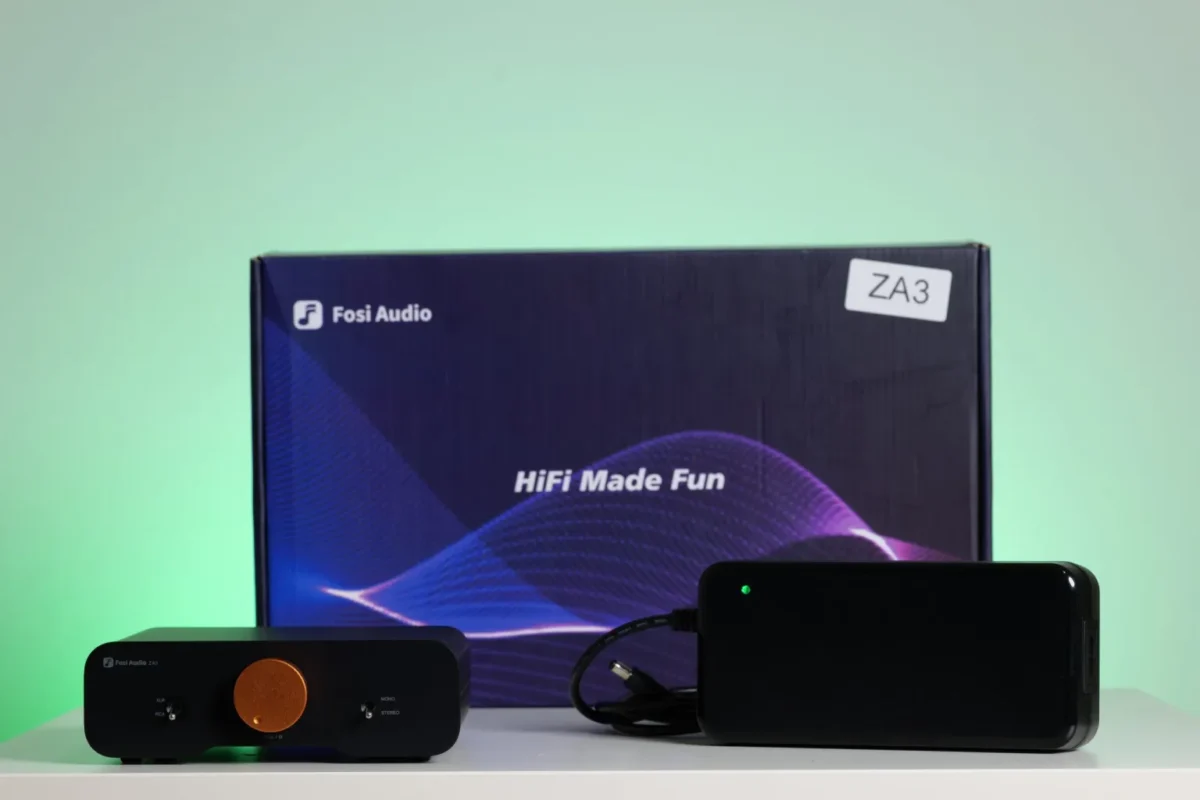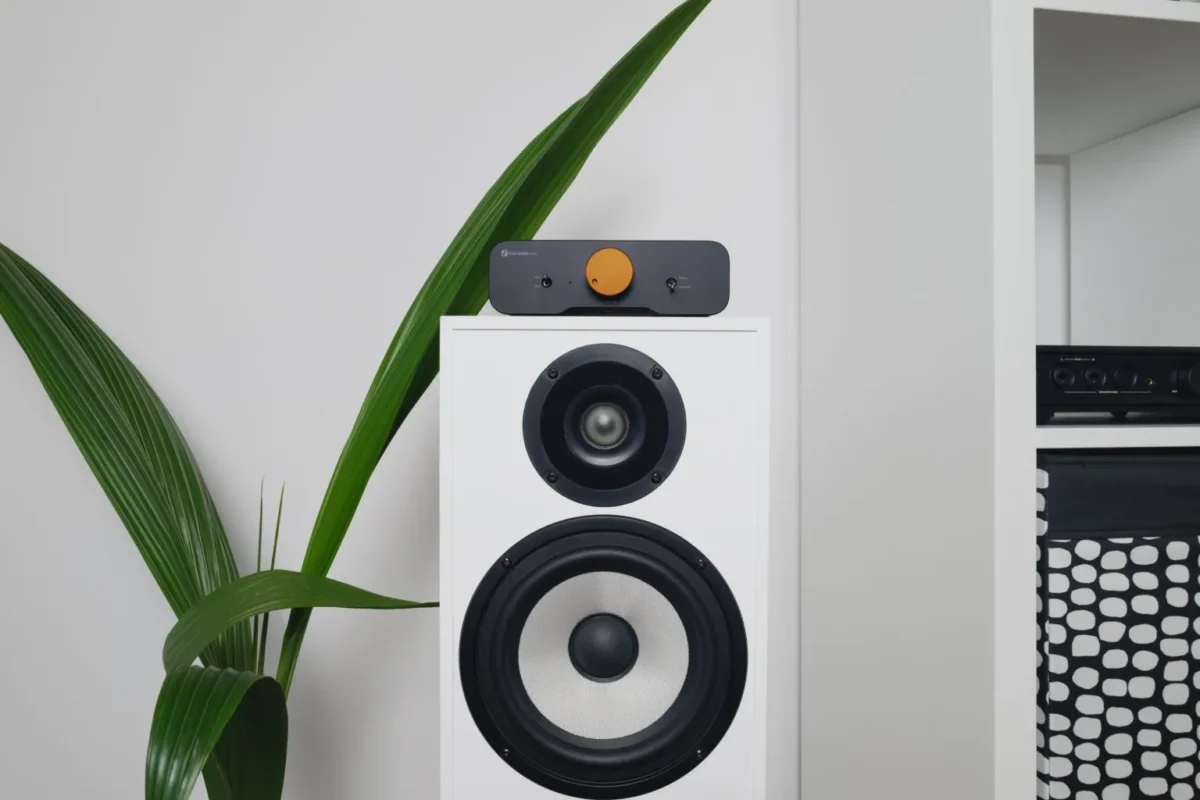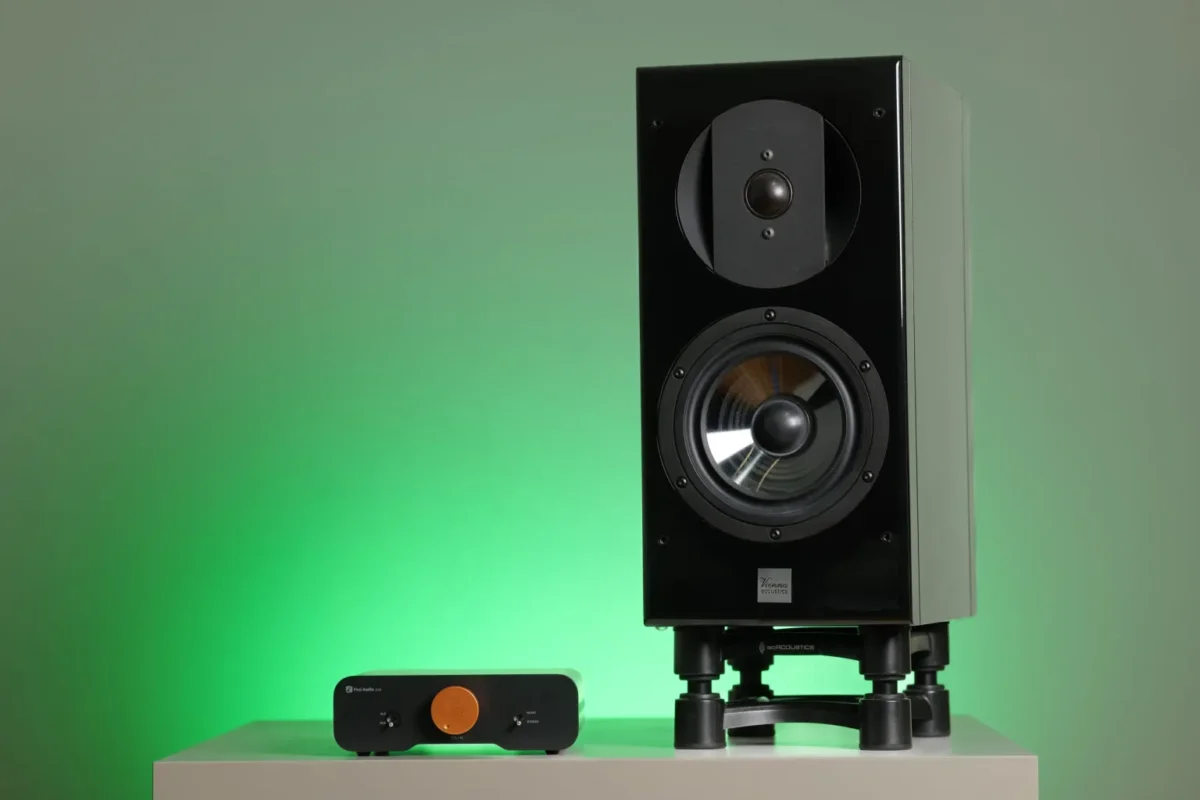Save Big on the Fosi Audio ZA3—Experience Pure Sound and Elevate Your Listening!… ( Now 10% OFF )
( To Learn More Read The Full Review Below )
When you buy through our links, we may earn a commission.
Fosi Audio ZA3 Balanced Stereo Amplifier
- PBTL Mono Mode Support
- XLR Input / 12V Trigger in
- Op-Amp Rolling: SS3602, MUSES02, OPA2134PA
- Replaceable Knobs: Black Knob
Click Below to Choose More Products.
Fosi Audio has made quite an impression with its lineup of highly affordable products. Among them, the ZA3 instantly grabbed my attention—after all, I’m equally passionate about both my headphones and my stereo setup. It’s been a while since I last reviewed any stereo gear, so skipping the chance to test this one would’ve been a real shame.
The ZA3 stands as Fosi’s current flagship integrated amplifier, surpassed only by the newer V3 Mono, a single-channel power amp. Both models are built around some of Texas Instruments’ finest class-D chips, though implemented in different ways.
So, what makes the ZA3 such a hit? It’s a blend of thoughtful design and impressive sound performance—features crafted with audio purity in mind. It packs more power than you’ll ever need, handles low-impedance loads effortlessly, offers solid specs, a clean look, and even includes a subwoofer output. But of course, none of that would matter if the sound itself didn’t deliver.
Everything arrives in a simple blue box—nothing fancy, but solidly built. The packaging uses dense foam inserts, similar to what you’d find with brands like Topping or SMSL. It’s a tried-and-true, budget-friendly approach. Inside, you’ll find just the essentials: the amplifier itself, a power supply, and a mains cable. Minimalist, but it helps keep costs down.
The included manual covers the basics of setup and offers a short note on op-amp swapping. However, it’s quite brief and doesn’t specify which types are recommended. It includes an image of the stock NE5532 and another of the Sparkos SS3602, along with a quick explanation on how to locate pin 1 of an op-amp—a handy tip for those unfamiliar with the process.
The chassis is made entirely of aluminum, with the main body formed from a single extruded sleeve and sealed by front and rear panels. Its color scheme combines dark grey with striking orange accents on the volume knob and ventilation grilles. There’s also a version featuring a dark grey knob, but it reportedly doesn’t sell as well—apparently, we all enjoy a little pop of color.
On the back, you’ll find small two-way binding posts that accept both banana plugs and bare wire. They’re quite compact, so using banana plugs is definitely the more convenient option. Overall, the build quality is impressive for this price range. My only gripe lies with the tiny speaker connectors, though that’s clearly a trade-off dictated by the amplifier’s compact size.
Inside, the ZA3 houses an array of high-quality components from reputable brands such as Wima, Nippon Chemicon, and Elna—nothing to complain about here. The stock op-amps are the tried-and-true NE5532 units from Texas Instruments, but those can be swapped if you’re into tweaking.
From a design standpoint, I only wish the front stereo/mono toggle had been placed on the back panel and replaced with a gain switch instead. When using the ZA3 in a nearfield setup, the gain felt a bit too high at times, and since there’s no remote control, that adjustment becomes all the more crucial.
However, when you look across Fosi Audio’s product lineup, one issue stands out: inconsistency. Every single unit seems to have a different look and size. The ZA3 doesn’t match the design of the ZD3 DAC/preamp, which in turn looks nothing like the V3 Mono amplifiers. Even the LC30 speaker selector—a handy device for people like me who constantly swap gear—comes in yet another shape and style. I really wish Fosi Audio would adopt a more unified design language, especially for products intended to be used together.
At the core of the Fosi Audio ZA3 lies the TPA3255, a Class-D amplifier chip developed by Texas Instruments. It’s widely recognized as one of the best in its class, capable of delivering a remarkable amount of clean power. With the included 48V power supply, the ZA3 outputs up to 155W per channel at 4Ω, while a 32V supply brings that down to around 95W per channel at 4Ω. In mono mode, the amp can push as much as 235W at 4Ω (or 110W with 32V). These are impressive figures for such a compact device—just keep in mind that the power supply itself is larger than the amp. My review unit came with the 48V version.
Unlike Fosi’s newer V3 Mono, the ZA3’s implementation of the TPA3255 doesn’t feature Post Filter Feedback (PFFB) technology. PFFB helps reduce distortion and output impedance even further, but even without it, the ZA3 delivers strong performance. The published specs claim THD below 0.006%, though Fosi doesn’t specify the test conditions.
Internally, the ZA3 is more sophisticated than its minimalist exterior suggests. It includes a fully featured preamp section with XLR and RCA inputs, a subwoofer output, and a line stage—each equipped with swappable op-amps in DIP8 sockets, allowing enthusiasts to fine-tune the sound to their liking. Fosi even encourages this level of customization. For this review, I’m using the stock NE5532 op-amps, but experimenting with discrete alternatives was certainly fun.
In terms of connectivity, the amplifier offers one XLR and one RCA input. While the internal circuitry isn’t fully balanced, the XLR inputs are managed by a dedicated op-amp. The sub out is a particularly nice addition—I paired my KEF LS50 speakers with an Audiovector Mi Sub Signature, and the synergy was excellent.
The ZA3 is designed as a no-frills integrated amplifier with just two inputs and no remote control, aside from a simple trigger input on the rear panel. It’s a trade-off: all your money goes into performance rather than convenience. On the flip side, you’ll have to get up to change the volume or switch inputs—something that’s not ideal after your third hot toddy. Still, I can’t help but wish Fosi would eventually release a full-sized integrated amp with multiple inputs, a phono stage, and a built-in DAC using the same design philosophy. That would be a serious challenge to the big-name brands that seem content to raise prices every year without real innovation.
In short, the Fosi Audio ZA3 keeps things clean and neutral — it truly follows the “wire with gain” philosophy. What immediately stood out to me was its remarkable control and detail, even when driving demanding speakers. Some might argue that the KEF LS50 Meta isn’t an ideal choice for desktop use, but I beg to differ. Despite their size and low sensitivity, the pairing sounded absolutely fantastic. A quality coaxial driver in a nearfield setup can do wonders for both gaming and movie sessions.
The ZA3 replaced the SMSL AO200 MKII in my setup, and after experimenting with op-amp swapping, I can confidently say it’s worth doing. The Sparkos SS3602 and Muzg Audio dual op-amps stood out, elevating the ZA3’s performance to a higher tier. For the sake of consistency, I conducted this review using the stock NE5532s to provide an “out-of-the-box” perspective — but yes, the extra power and control here make op-amp rolling genuinely rewarding.
Throughout testing, the ZA3 handled a wide range of speakers — bookshelf, floorstanders, even a pair of ceiling speakers — with ease. What impressed me most is how comfortably it drives gear that costs several times more. Thanks to its clean resolution and excellent clarity, the ZA3 scales beautifully with higher-end components, revealing their strengths rather than limiting them.
Bass
The Fosi Audio ZA3 delivers bass that is both clean and authoritative. It reproduces exactly what’s on the recording — nothing more, nothing less. Its control over the drivers is exceptional, even with challenging speakers like the multi-driver Pylon Pearl 27 or the low-sensitivity KEF LS50 Meta. The lows are taut, textured, and full of definition. Listening to Bob Marley’s “Buffalo Soldier” revealed just how well the amp handles basslines — rich textures, solid extension, and no muddiness. The extra power definitely helps extract deeper frequencies, even from smaller speakers.
Switching to The Weeknd’s “Save Your Tears” with the bass-heavy Pylon Pearl 27, I was pleased to find the ZA3 keeping everything tight and punchy without bloat. The low end carried proper weight and slam — exactly what you want for modern pop — while maintaining composure. Even in larger rooms, dynamics were exceptional for the class. The bass was balanced and never intruded on the midrange. Speaking of which…
Midrange
This is where the ZA3 truly shines in terms of dynamics and precision. Guitars in Dire Straits’ “Southbound Again” sounded crisp and engaging, with an instant sense of attack and liveliness. Mark Knopfler’s vocals sit slightly behind the instruments, contributing to a natural sense of stage layering. If you’re after warmth or coloration, the ZA3 may not be your flavor — this amp prioritizes accuracy over sweetness. It gives you exactly what you feed it, for better or worse.
Playing Florence + the Machine’s “No Light, No Light (Unplugged)” further highlighted the amp’s agility and composure. It transitioned effortlessly from quiet to loud passages, maintaining both tonal balance and clarity. The piano was distinctly separated from Florence’s vocals — something rarely achieved at this price point.
Treble
High frequencies are crisp, refined, and full of sparkle. Gone are the days when Class-D meant brittle treble — even without PFFB, the ZA3 delivers impressive results. The cymbals in Yusef Lateef’s “Bishop School” flowed naturally with fine separation and air. There’s a sense of precision and control that keeps things engaging without crossing into harshness.
For a real test, I played “Bamboche” by Jean-Louis Beaumadier, a challenging track for any amp. Here, the ZA3 showed the limits of its class — while it handled the piece admirably, it couldn’t quite match the refinement and microdetail of a higher-end Class-AB design. Still, within its price bracket, the ZA3’s treble performance remains ahead of most Class-D competitors.
Soundstage
The ZA3 creates an impressively wide stereo image, with strong separation and clear positioning between speakers. Lateral spread is excellent, though depth could be better. Listening to “Take Five” from Arne Domnerus’ Jazz at the Pawnshop, the ZA3 presented instruments with great precision but a somewhat shallower stage.
Its soundstage feels wide yet relatively flat — instruments extend far left and right, but not as much forward or backward. Interestingly, its main rival takes the opposite approach: narrower but deeper imaging. So, as always, it comes down to personal preference — do you prefer a broad, open stage or one with more dimensional layering?
Pylon Audio Pearl 27
During my (sadly brief) time with the Pylon Audio Pearl 27, I found it to be an excellent match for larger rooms. The Fosi ZA3’s neutral tuning complements this speaker beautifully, and it had more than enough power to fill a 40-square-meter space with full, musical sound. It’s one of the most enjoyable combinations I’ve experienced during my months with the ZA3.
One of the reasons I enjoy reviewing affordable audio gear is precisely to discover gems like this. Why hunt for 30-year-old amps and vintage speakers on the second-hand market when, for roughly €900 in Europe, you can achieve this level of sound quality—brand new, under warranty, and made in Poland? Sure, you could go cheaper with used gear, but the value here borders on unbelievable.
The Pearl 27 delivers a neutral, well-balanced signature and truly behaves like a jack-of-all-trades. I might sound biased, but I honestly can’t find a real flaw at this price point. The soundstage is solid, the bass is powerful and articulate, the midrange is musical, and the treble is extended yet pleasant. And the dynamics? Don’t even get me started. Perhaps the cabinet design looks a bit plain, but don’t let the photos fool you—it’s a solid, well-built, and elegant speaker. If you have the space and budget, this pairing is a no-brainer.
KEF LS50 Meta + Audiovector Mi Sub Signature
These are the crown jewels of my stereo setup, and I absolutely adore them—especially because I use them in both nearfield and traditional listening configurations. Paired with the ZA3, they created an exceptionally cohesive and immersive experience. The sound completely detached from the speakers; more than once, I forgot they were even in front of me. The synergy worked beautifully across music, movies, and games, demonstrating just how capable the ZA3 truly is.
The KEF LS50 Meta is notoriously demanding due to its low sensitivity and impedance, yet the ZA3 drove it with confidence and finesse. The resulting sound leaned toward cleanliness and refinement, offering superior detail, resolution, and imaging compared to the Pearl 27—but naturally, at the expense of low-end weight and sheer dynamics. Adding the Audiovector Mi Sub Signature fixed that, turning the system into a perfectly balanced setup.
This combination is ideal for listeners who prioritize precision, dynamics, and a spacious, airy soundstage. Sure, a higher-end amplifier can push these speakers further, but with the ZA3, you’re already getting 85–90% of that performance—at a fraction of the cost. If you aim high but your budget doesn’t quite reach the stars, the ZA3 is a brilliant starting point.
Vienna Acoustics Haydn Grand
Yet another case of the Fosi Audio ZA3 punching above its weight. It drives the Vienna Acoustics Haydn Grand effortlessly, and the result is anything but “budget sound.” This pairing offers a level of detail and refinement similar to the LS50 setup, but with a smoother, more relaxed presentation. While the LS50s can occasionally sound sharp or analytical, the Haydn Grand never does—it’s consistently musical and easy to listen to.
The soundstage and resolution remain strong, and while this may not be the “perfect” pairing, it’s a highly capable one. If you’ve invested in a great set of speakers but can’t yet afford a high-end amplifier, the ZA3 will absolutely step up. It won’t limit the character of your speakers—in fact, it will help you understand them better.
Could these speakers sound even better with a more powerful amp? Of course. But the ZA3 still brought me plenty of joy, and that’s saying something. And yes, I’d love to hear what these speakers can really do with something bigger and meaner—but that’s a story for another day.
SMSL AO200 MKII
The SMSL AO200 MKII had been my go-to desktop amplifier for quite some time. It paired nicely with my KEF LS50 Meta, serving reliably until the Fosi ZA3 came along and replaced it. The ZA3 simply offered a cleaner, more spacious presentation and took up less space on my desk. That said, the SMSL is far from obsolete — it’s still a capable, feature-packed amplifier that can easily tilt the balance in its favor depending on what you need.
The AO200 MKII comes equipped with more integrated functionality than the ZA3: a built-in (albeit mediocre) DAC, Bluetooth connectivity, and EQ/tone controls, which many casual listeners will appreciate. For non-critical listening, these additions do a fine job and make it a more convenient all-in-one solution.
When it comes to sound, though, the two amps take quite different approaches. The AO200 MKII is noticeably warmer and fuller-bodied, with bigger, bolder bass. However, it lacks the bass extension and fine detail that the ZA3 effortlessly delivers. The SMSL’s midrange has a more colored and lush presentation, which can sound pleasantly natural to some ears, but it doesn’t quite match the ZA3’s dynamic drive and resolving power.
As for the treble, the SMSL follows the same trend — it’s smoother and easier on the ears, but less extended and crisp compared to the ZA3. Depending on your speakers and taste, that can either be a plus or a minus. The soundstage of the SMSL is also more intimate and natural, with width and depth roughly balanced, while the ZA3 emphasizes depth more strongly, creating a slightly grander and more holographic stage. The SMSL also plays closer to the listener, a characteristic that some might find engaging for nearfield listening.
In summary, the SMSL AO200 MKII offers more features and a more forgiving, relaxed sonic character, while the Fosi ZA3 pushes further in clarity, dynamics, and spatial performance, though it’s a bit pickier with system matching. Both are excellent choices, but for very different reasons — which makes this kind of comparison the best kind of competition.
Final Verdict — Fosi Audio ZA3
So, what exactly is the Fosi Audio ZA3? It’s an incredibly capable yet refreshingly simple integrated amplifier, offered at a price that borders on unbelievable. If you’re after an amp that adds nothing to the signal and drives just about anything you throw at it, look no further — this is precisely what the ZA3 was built for.
Its “wire with gain” sound signature means you’ll hear exactly what your source and speakers are capable of — nothing more, nothing less. It handles virtually any sensible speaker in any reasonable room, and even when paired with gear far above its price class, it never sounds cheap or out of place.
The ZA3 is a fantastic gateway into high-fidelity stereo. It can easily serve as a temporary solution while you build your system, or — for many listeners — the first and last amplifier they’ll ever need.
At this price point, there’s hardly anything else that delivers such a clean, powerful, and transparent sound in such a compact form. Kudos to Fosi Audio for bringing this little gem to market. It’s an instant classic — the kind of amp that quietly redefines what’s possible for the money.





